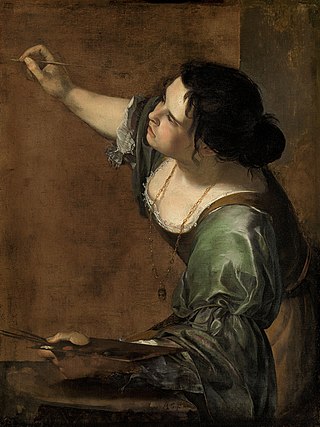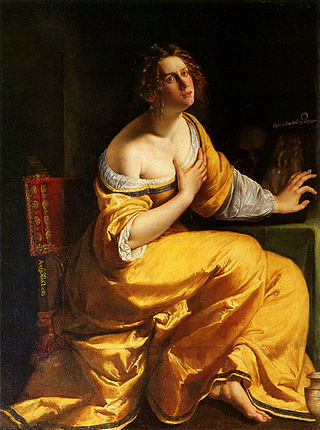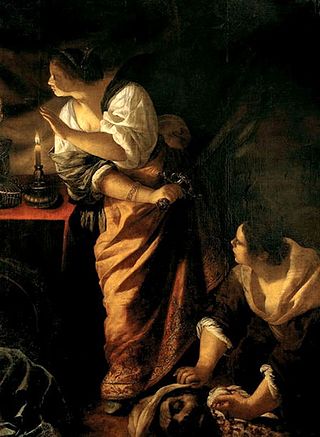
Artemisia Lomi or Artemisia Gentileschi was an Italian Baroque painter. Gentileschi is considered among the most accomplished 17th-century artists, initially working in the style of Caravaggio. She was producing professional work by the age of 15. In an era when women had few opportunities to pursue artistic training or work as professional artists, Gentileschi was the first woman to become a member of the Accademia di Arte del Disegno in Florence and she had an international clientele.

Judith Beheading Holofernes is a painting of the biblical episode by Caravaggio, painted in c. 1598–1599 or 1602, in which the widow Judith stayed with the Assyrian general Holofernes in his tent after a banquet then decapitated him after he passed out drunk. The painting was rediscovered in 1950 and is part of the collection of the Galleria Nazionale d'Arte Antica in Rome. The exhibition 'Dentro Caravaggio' Palazzo Reale, Milan, suggests a date of 1602 on account of the use of light underlying sketches not seen in Caravaggio's early work but characteristic of his later works. The exhibition catalogue also cites biographer artist Giovanni Baglione's account that the work was commissioned by Genoa banker Ottavio Costa.

Massimo Stanzione was an Italian Baroque painter, mainly active in Naples, where he and his rival Jusepe de Ribera dominated the painting scene for several decades. He was primarily a painter of altarpieces, working in both oils and fresco. His main subject matter was biblical scenes. He also painted portraits and mythological subjects. He had many pupils and followers as his rich color and idealized naturalism had a large influence on other local artists, such as Francesco Solimena. In 1621 Pope Gregory XV gave him the title of Knight of the Golden Spur and Pope Urban VIII made him a knight of St. John around 1624 and a knight of the Order of Christ in 1627. From then on, he liked to sign his works as "EQUES MAXIMUS".

The account of the beheading of Holofernes by Judith is given in the deuterocanonical Book of Judith, and is the subject of many paintings and sculptures from the Renaissance and Baroque periods. In the story, Judith, a beautiful widow, is able to enter the tent of Holofernes because of his desire for her. Holofernes was an Assyrian general who was about to destroy Judith's home, the city of Bethulia. Overcome with drink, he passes out and is decapitated by Judith; his head is taken away in a basket.

Self-Portrait as the Allegory of Painting, also known as Autoritratto in veste di Pittura or simply La Pittura, was painted by the Italian Baroque artist Artemisia Gentileschi. The oil-on-canvas painting measures 98.6 by 75.2 centimetres and was probably produced during Gentileschi's stay in England between 1638 and 1639. It was in the collection of Charles I and was returned to the Royal Collection at the Restoration (1660) and remains there. In 2015 it was put on display in the "Cumberland Gallery" in Hampton Court Palace.

David with the Head of Goliath is a painting by Italian Baroque artist Massimo Stanzione, created c. 1642–1643. It is now in the San Diego Museum of Art.

Judith and the Head of Holofernes is an oil painting by Gustav Klimt, painted in 1901. It depicts the biblical figure Judith holding the head of Holofernes after beheading him. The beheading and its aftermath have been commonly portrayed in art since the Renaissance, and Klimt himself would paint a second work depicting the subject in 1909.
Judith and Holofernes may refer to:

Susanna and the Elders is a 1610 painting by the Italian Baroque artist Artemisia Gentileschi and is her earliest-known signed and dated work. It was one of Gentileschi's signature works. She painted several variations of the scene in her career. It hangs at Schloss Weißenstein in Pommersfelden, Germany. The work shows a frightened Susanna with two men lurking above her while she is in the bath. The subject matter comes from the deuterocanonical Book of Susanna in the Additions to Daniel. This was a popular scene to paint during the Baroque period.

Esther Before Ahasuerus is a painting by the 17th-century Italian artist Artemisia Gentileschi. It shows the biblical heroine Esther going before Ahasuerus to beg him to spare her people. The painting is now in the Metropolitan Museum of Art in New York, having been donated to the museum by Elinor Dorrance Ingersoll in 1969. It is one of Gentileschi's lesser known works, but her use of lighting, characterization, and style help in successfully portraying Esther as a biblical heroine as well as the main protagonist of the work.

Judith and her Maidservant is a c. 1615 painting by the Italian baroque artist Artemisia Gentileschi. The painting depicts Judith and her maidservant leaving the scene where they have just beheaded general Holofernes, whose head is in the basket carried by the maidservant. It hangs in the Pitti Palace, Florence.
This is an ongoing bibliography of work related to the Italian baroque painter Artemisia Gentileschi.

Self-Portrait as a Lute Player is one of many self-portrait paintings made by the Italian baroque artist Artemisia Gentileschi. It was created between 1615 and 1617 for the Medici family in Florence. Today, it hangs in the Wadsworth Atheneum Museum of Art, Hartford, Connecticut, US. It shows the artist posing as a lute player looking directly at the audience. The painting has symbolism in the headscarf and outfit that portray Gentileschi in a costume that resembles a Romani woman. Self-Portrait as a Lute Player has been interpreted as Gentileschi portraying herself as a knowledgeable musician, a self portrayal as a prostitute, and as a fictive expression of one aspect of her identity.

Judith and Her Maidservant is one of four paintings by the Italian baroque artist Artemisia Gentileschi that depicts the biblical story of Judith and Holofernes. This particular work, executed in about 1623 to 1625, now hangs in the Detroit Institute of Arts. The narrative is taken from the deuterocanonical Book of Judith, in which Judith seduces and then murders the general Holofernes. This precise moment illustrates the maidservant Abra wrapping the severed head in a bag, moments after the murder, while Judith keeps watch. The other three paintings are now shown in the Museo di Capodimonte in Naples, the Palazzo Pitti in Florence, and the Musée de la Castre in Cannes.

Penitent Magdalene is a 1616–1618 painting by the Italian baroque artist Artemisia Gentileschi. This painting hangs in the Pitti Palace in Florence. The subject is the biblical figure Mary Magdalene, but the painting references another biblical woman, Mary, the sister of Lazarus. This painting was likely painted during Gentileschi's Florentine period.

Saint Catherine of Alexandra is a painting by the Italian Baroque artist Artemisia Gentileschi. It is in the collection of the Uffizi, Florence. Gentileschi likely used the same cartoon or preparatory drawing to create both this painting and the Self-Portrait as Saint Catherine of Alexandria (1615–1617), now in the National Gallery, London.

Judith and Her Maidservant is a painting by the Italian baroque artist Artemisia Gentileschi. Executed sometime between 1640 and 1645, it hangs in the Musée de la Castre in Cannes.

Lucretia is a painting by the Italian baroque artist Artemisia Gentileschi. It depicts Lucretia, the wife of Roman consul and general Collatinus, at the moment of her suicide. The decision to take her own life was made after she was blackmailed and raped by Sextus Tarquinius, a fellow soldier of Collatinus. It is one of a number of paintings of Gentileschi that focus on virtuous women ill-treated by men.

Judith Slaying Holofernes c. 1620, now at the Uffizi Gallery in Florence, is the renowned painting by Baroque artist Artemisia Gentileschi depicting the assassination of Holofernes from the apocryphal Book of Judith. When compared to her earlier interpretation from Naples c. 1612, there are subtle but marked improvements to the composition and detailed elements of the work. These differences display the skill of a cultivated Baroque painter, with the adept use of chiaroscuro and realism to express the violent tension between Judith, Abra, and the dying Holofernes.

Judith and her Maidservant with the Head of Holofernes is a painting by the Italian artist Artemisia Gentileschi, created in 1639-1640. It was one of many paintings by Gentileschi that treats the theme of Judith, who beheads the Assyrian general Holofernes, who was planning to destroy Judith's home city of Bethulia.




















